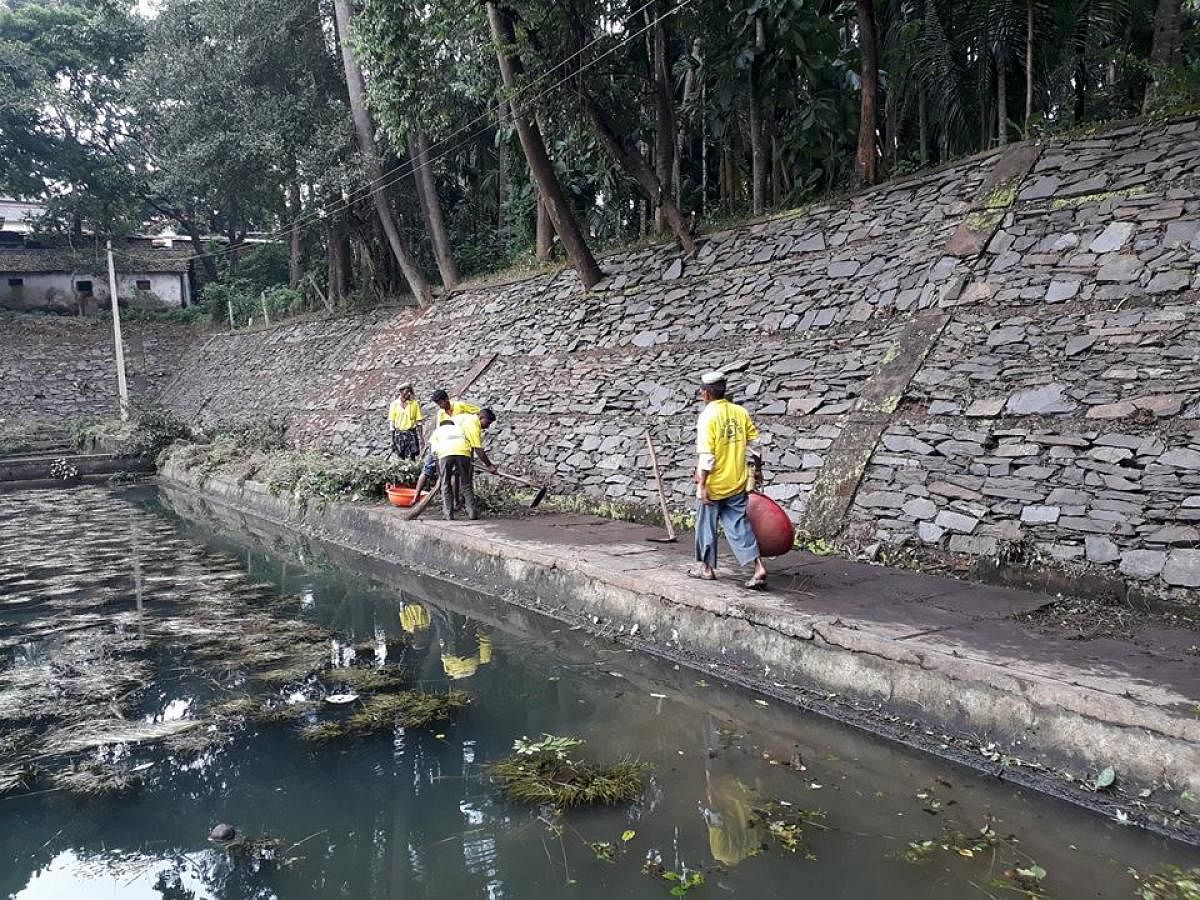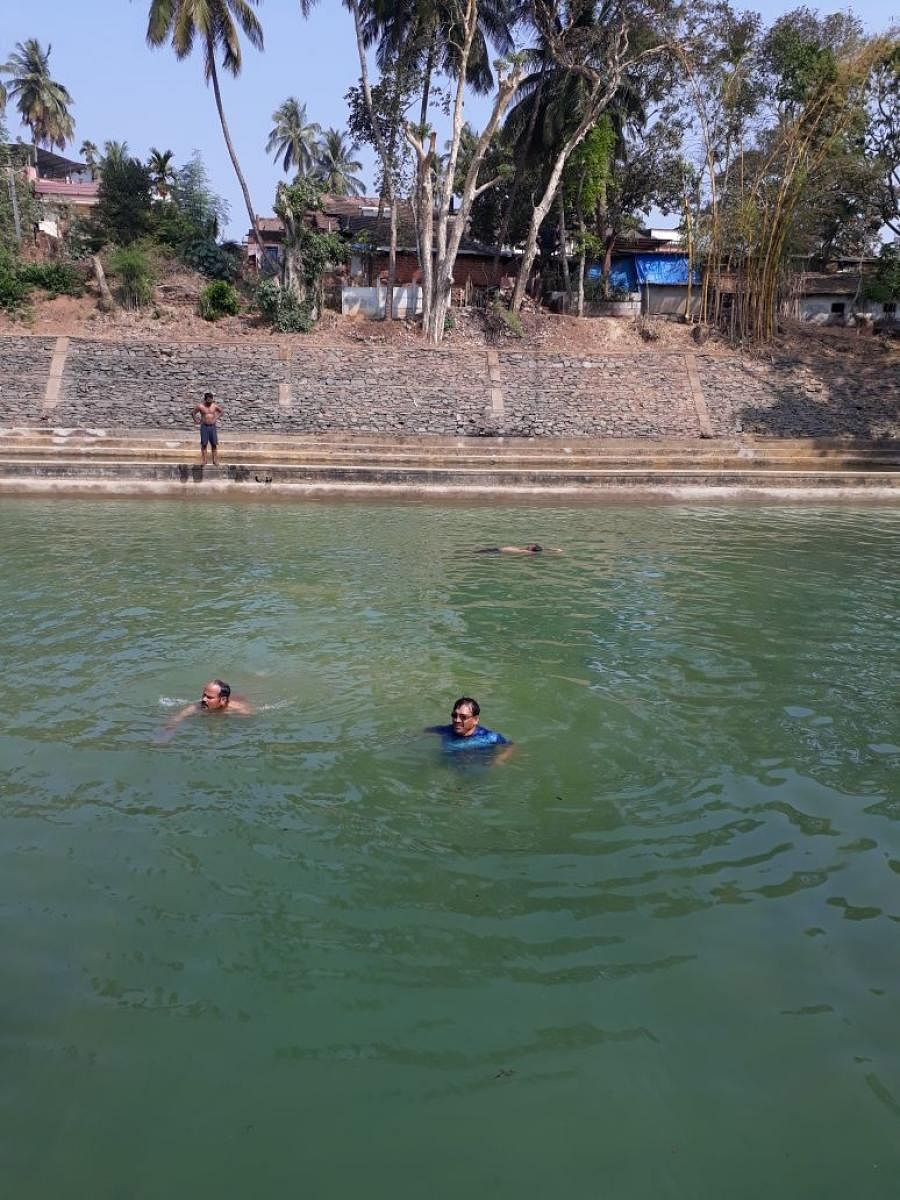

Though late, monsoon has arrived in full fury in almost all parts of the state. As the dreams of a good crop are being swept away by the floods in North Karnataka, the post-monsoon situation doesn’t seem to be bright either. Reason: rainwater is yet to replenish groundwater aquifers in many parts of the state. People are waking up to the situation and working towards reviving traditional water sources which play a crucial role in maintaining the water table. One such citizens’ initiative in Sirsi has rejuvenated ponds and tanks of the town with least government assistance.
In the last few years, Sirsi town in Uttara Kannada district has been facing acute water shortage. While reduced rainfall is one of the reasons, this situation, people have now realised, is mainly due to the neglect of water sources.
Though situated in the midst of Western Ghats, receiving an annual rainfall of above 2500 mm a year and having more than 15 ponds and tanks, water had to be supplied to Sirsi town in tankers as the regular water sources such as Kengre and Marigadde rivulets of the Aghanashini river had dried up.
Rejuvenation works
In 2017, the citizens of Sirsi decided to look at the long-term solutions for the recurring problem. A meeting was held in this regard which was attended by people from across crosssections to discuss the issue. The revival of existing water bodies as a long-term solution was one of the several ideas proposed. Rainwater harvesting from buildings and creating awareness among the public for water conservation were other workable ideas. It was decided to take up tank rejuvenation work with a participatory approach.
In order to achieve the goal, a task force was formed with the name ‘Sirsi Jeeva Jala Kaaryapade’ with industrialist Srinivas Hebbar as the president and writer Shivananda Kalave as an honorary advisor.
The team first chose to desilt Ane Honda, a neglected tiny pond situated on the outskirts of the town. The silted pond looked more like a piece of land. As the excavators and tractors lined by, on the first day itself contributions for the cause started pouring in. About four lakh rupees were collected from various individuals and organisations that day.
“This gave us the confidence that the public supports a good work,” recollects Srikant Hegde, a member of the task force. “The first contribution was from the assistant commissioner himself who paid Rs 10,000 from his pocket showing solidarity to the cause.”
Within a span of about 15 days, the pond was unearthed to an average depth of 10 feet in about a quarter-acre area of the pond. As the water started collecting in, a Kere Habba (pond festival) was organised on the banks of this pond to celebrate the success. As part of World Environment Day, a short video was released on social media to spread awareness and draw the attention of the general public towards reviving lakes.
Buoyed by the success of Ane Honda, desilting of Rayana Kere, another pond in the outskirts of the town, a much bigger one, was taken up. In record time, thousands of truckloads of the earth was moved. Within a short span of time, the work of the task force became the talk of the town. People started asking about the next lake in line for revival and actively extended support.
Subsequently, Bashetty Kere, Bellakki Kere, Shankara Honda, Haladota Kere, Suprasanna Nagara Kere were revived. Depending on the convenience, 10-20 feet of earth was dug and evacuated in these ponds. These had an area ranging from a quarter of an acre to four acres. By next monsoon, all these were full of water much to the delight of people who had contributed their time and money. The total expenditure of these work crossed one crore rupees.
“Though some organisations contributed money, it was sufficient only to about a quarter of the actual expenditure,” says Srinivas Hebbar. Rest of the cost was borne by Hebbar himself. “The driving force behind me is that I was born and brought up on the banks of River Aghanashini, where I used to swim during my childhood days. This close association with water had a deep influence on me and without a second thought, I took the opportunity when it came my way,” he said.
“The success of the task could be greatly attributed to the efforts of Assistant Commissioner K Raju Mogaveera and Srinivas Hebbar,” says Srikant.
Not a smooth flow
Demarcating the boundaries of the lakes and ponds was done before starting the desilting work. Encroachment at the tank bunds was a challenge to address. Thankfully, seeing the gravity of the crisis, people voluntarily came forward to vacate the encroached area and made contributions too.
In one case, a religious organisation which was initially apprehensive about the work supported the cause upon seeing the advantages of desilting. Subsequently, desilting work was carried out in a tank that was owned by the organisation.
“Lakes are crucial for groundwater recharging,” says Shivanand Kalave who offered technical guidance to the team. “In the past two years, people have seen the changes and realised the crucial role lakes play in sustaining the water crisis. The model can be replicated across the state,” he adds.
“Desilting lakes was a big challenge in terms of the huge amount of earth to be moved. I bought an earth-mover for Shankara Honda rejuvenation which had literally turned into a dumping yard. But now it has become a tourist attraction,” says Srinivas Hebbar. The work was completed in six months. This pond from where River Aghanashini originates is now brimming with water throughout the year. Two paddle boats, a water spring and bathing points are some of the attractions that draw tourists here. People walk around the paved banks of this picturesque pond delightfully.
Remarkable impact
The impact of the rejuvenation work is clearly visible in the town. “Open wells around Bellakki Kere now have water at 10 feet depth,” says V P Hegde Vaishali, a resident of Marathikoppa area near the lake. Sufficient moisture keeps areca plantations near Ane Honda stay green even at peak summer. “We had to use the water from our open well carefully during the summer months. Since the tank was desilted, water has never dried up,” says Dr Ashvini Koppal whose residence is near the lake at Khoorse compound. Several other residents of the area, too, have a similar opinion. “Earlier, it was a sorry sight at Shankara Honda. Now it has become a prime spot in this area. All thanks to Jeeva Jala Karyapade,” says Prasanna, a resident of Halonda Badavane, which is adjacent to the lake.
Water conservation was taken to the next level at a village near Banavasi where a lake was desilted and aquaculture was introduced. A part of the profit would be utilised for the maintenance of the lake.
From Aane Honda which covers half an acre area to the three-and-a-half-acre Rayana Kere, as many as eight water sources have been rejuvenated under this initiative in the last two years. Over 100 acres of paddy field and areca plantation have been benefitted and open wells in about 500 houses have been recharged due to this water conservation work.
People around Rayana Kere have come together in the pretext of conservation of this lake and continue to meet regularly to discuss and act towards the maintenance of the lake, deal with pollution, beautification of the area, planting of trees etc.
Encouraged by the success of this campaign, people from other parts of the district have sought assistance to rejuvenate tanks at their places also. Karyapade is open to take up such tasks with the active participation of local people. “An example is being set. It is up to communities to now plan and emulate water conservation efforts as per local needs,” opines Shivananda Kalave.